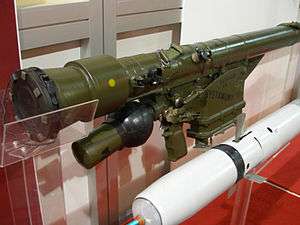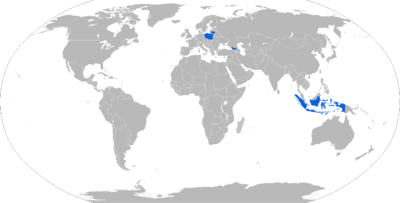Grom (missile)
| PZR Grom | |
|---|---|
 PZR Grom missile with launcher | |
| Type | Man-Portable SAM |
| Place of origin | Poland |
| Service history | |
| In service | 1995–present |
| Used by | See Operators |
| Wars |
2008 Russian-Georgian War Second Chechen War War in Donbass |
| Production history | |
| Designer | Military Institute of Armament Technology, WAT Military University of Technology, Skarżysko Rocket Design Bureau |
| Manufacturer | Mesko, Skarżysko-Kamienna |
| Produced | 1995–present |
| Specifications | |
| Weight | 16.5 kilograms (36 lb), and for missile only 10.5 kilograms (23 lb) |
| Diameter | 72 millimetres (2.8 in) |
| Warhead weight | 1.27 kilograms (2.8 lb) |
Detonation mechanism | contact |
|
| |
| Engine | solid fuel rocket |
Operational range | 5.5 kilometres (3.4 mi) |
| Flight altitude | 3.5 kilometres (11,000 ft) |
| Speed | 650 metres per second (2,100 ft/s) |
Guidance system | infrared |
Launch platform | MANPADS |
The Grom (meaning "thunder" in Polish) is a man-portable air-defense system produced in Poland. It consists of a 72 mm anti-aircraft missile set with a flight speed of 650 m/s, as well as a single-use launcher, re-usable gripstock and thermal battery coolant assembly electric unit. The full name of the system is PZR Grom, PZR standing for Przeciwlotniczy Zestaw Rakietowy (literally anti-air rocket-propelled set).
It is designed to target low-flying helicopters and aeroplanes. As such, the Grom missile is used by other surface-to-air defence systems of Polish design, including ZSU-23-4MP Biała, ZUR-23-2 kg and POPRAD self-propelled artillery system. It should not to be confused with versions of the Zvezda Kh-23 air-to-surface missile built under licence in Yugoslavia/Serbia as the Grom-A and Grom-B.
History

Initially at least since the 1970s the MESKO metal works in Skarżysko-Kamienna mass-produced license-built Soviet Strela-2M (SA-7 Grail) surface-to-air missiles, designated in Poland as Strzała-2M. However, when these became outdated in the late 1980s the lead designers prepared the works to produce a more modern Soviet design, the 9K38 Igla (SA-18 Grouse). However, Poland left the Soviet bloc in 1990 and the license was declined, thus leaving Poland with no modern MANPADS at hand.
Because of that, in late 1992 various Polish works and design bureaus (among them the Zielonka-based Military Institute of Armament Technology, the WAT Military University of Technology and the Skarżysko Rocket Design Bureau) started working on a new Igla-like design. These were allegedly helped by the Polish intelligence services able to buy the design plans of the original 9K38 Igla missile system in the LOMO works in Leningrad (modern St. Petersburg) during the turmoil following the dissolution of the Soviet Union.[1] By 1995 the first batch (marked as GROM-1) entered service. It included a number of imported Russian components. By the late 1990s these were replaced with entirely Poland-designed elements.
On January 1, 2013, Bumar Amunicja manufactured their 2,000th Grom missile set.[2]
Grom was later improved into what became known as the Piorun, with a new seeker and rocket motor.[3]
Design
The system is designed to be operated by one soldier. It consists of a single-stage projectile, a single-use tubular launcher, a starting mechanism, and an on-ground power supply. The rocket projectile uses solid propellant. The infrared aiming sensor is cooled with liquid nitrogen. There are options for identification friend or foe and thermovision.
Operational history
The 'Grom' has been used by Polish Land Forces since 1995.[4] It is also exported to other countries, including Georgia which bought 30 launchers and 100 missiles in 2007.[4] According to press releases during the Russo-Georgian War, Polish-made GROM missiles targeted Russian planes and helicopters 20 times, 12 missiles were fired out of which 9 hit their targets, and most likely shot down a Su-25.[1]
Indonesian Army bought 155 GROM missiles as part of Kobra V-SHORAD system.[5][6]
Lithuania plans to buy approx 25 launchers and unknown number of missiles for 10 million €[7][8]
Political relevance
In late 2008 Russian press claimed that Russian army personnel had found Polish GROM missiles in Chechnya. Polish press immediately reacted accusing Russia of fabricating evidence which links Poland to that conflict, claiming that missiles were moved by Russians from Georgia to Chechnya.[9]
Operators

Current operators





Evaluation only
See also
References
- 1 2 jagor, PAP (August 2009). "Polska broń w służbie gruzińskiej armii". Gazeta Wyborcza (in Polish) (2009-08–10).
- ↑ 2,000th Grom missile set - Armyrecognition.com, January 1, 2013
- ↑ http://nationalinterest.org/blog/the-buzz/how-poland-would-defend-its-skies-russia-missiles-migs-25497
- 1 2 Michał Majewski, Paweł Reszka (August 2009). "Polska broń w służbie gruzińskiej armii". Dziennik (in Polish) (2009-08–10).
- ↑ "KOBRA VSHORAD INDONESIA ARMY EXPANDING SUPPLIER BASE WITH POLAND ARMY". Retrieved 2012-06-22.
- ↑ http://defense-studies.blogspot.com/2012/06/pt-di-mendapatkan-kontrak-pembuatan.html
- ↑ http://www.defence24.pl/news_litwa-kupuje-polskie-manpads
- ↑ "Archived copy". Archived from the original on 2014-03-28. Retrieved 2014-03-27.
- ↑ http://wiadomosci.gazeta.pl/Wiadomosci/1,80625,5839057,Polskie_rakiety_Rosjanie_wywiezli_z_Gruzji__a_nastepnie.html
- 1 2
- ↑ http://geo-army.ge
- ↑
- "Lithuania signs contract on purchase of GROM air-defense system". Delfi. 3 September 2014. Retrieved 2014-09-03.
- 1 2
- ↑ http://www.polska-zbrojna.pl/home/articleshow/12516?t=Pioruny-zastapia-Gromy/